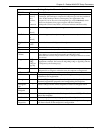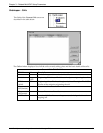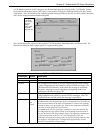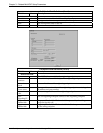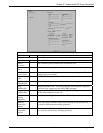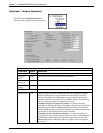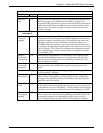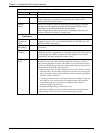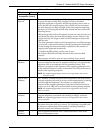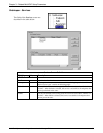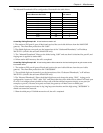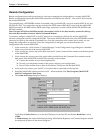
Chapter 3 – Related MultiVOIP Setup Parameters
62 Multi-Tech Systems, Inc. Avaya Communication Manager Guide
Network Parameter Definitions (cont’d)
Field Name Values Description
Configuration
Parameters (Cont’d)
Call IRQ
Interval
The interval, in seconds, between IRQ messages sent by the Gatekeeper
to query the status of calls. IRQ messages are sent to all online
endpoints registered as dynamic and having ongoing calls in order to
verify that the calls are still ongoing. The number you set determines
the delay between two IRQ messages to the same endpoint regarding
the same call. Choosing the desired delay should take into account the
following factors:
IRQ messages add to the traffic already present over the network, and
the shorter the delay, the more IRQ messages are sent. However, the
longer the delay, the longer it takes for the Gatekeeper to detect calls
that are stale.
The delay parameter relates to the interval between two IRQ messages
per one call, so the actual number of the IRQ messages the Gatekeeper
creates during this interval should be multiplied by the number of
ongoing calls registered dynamically.
To disable the IRQ polling, set this value to zero.
The effective IRQ interval cannot fall below three times the RAS
timeout.
IRQ messages will not be sent at a rate exceeding 20 per second.
Default
Distance
The “distance” (number device-to-device hops that a call must traverse
between endpoints) allowed for endpoints which are only dynamically
registered, such as an endpoint with no predefined values. This
distance is compared to the distances of the neighbor gatekeepers and
to the multicast distance in order to determine if an LRQ can be sent on
behalf of the requesting endpoint.
NOTE: The neighboring gatekeeper feature is not supported in the current
software version.
Out-of-Zone
Distance
The “distance” (number device-to-device hops that a call must traverse
between endpoints) allowed for an out-of-zone endpoint that is making
a call through the Gatekeeper. This distance is compared to the
distances of the neighbor gatekeepers and to the multicast distance in
order to see if an LRQ can be sent on behalf of the requesting endpoint.
NOTE: The neighboring gatekeeper feature is not supported in the current
software version.
Multicast
Distance
The “distance” (number device-to-device hops that a call must traverse
between endpoints) associated with sending an LRQ by multicast.
NOTE: The neighboring gatekeeper feature is not supported in the current
software version.
GK-ID The name of the Gatekeeper. The terminals identify the Gatekeeper by
this name during the discovery process. The Gatekeeper responds only
to Discovery requests that either contain a matching Gatekeeper
identifier or have no Gatekeeper identifier.
Update
(button)
-- Click to update information in the “Status Information” fields of the
Network Parameters screen.



